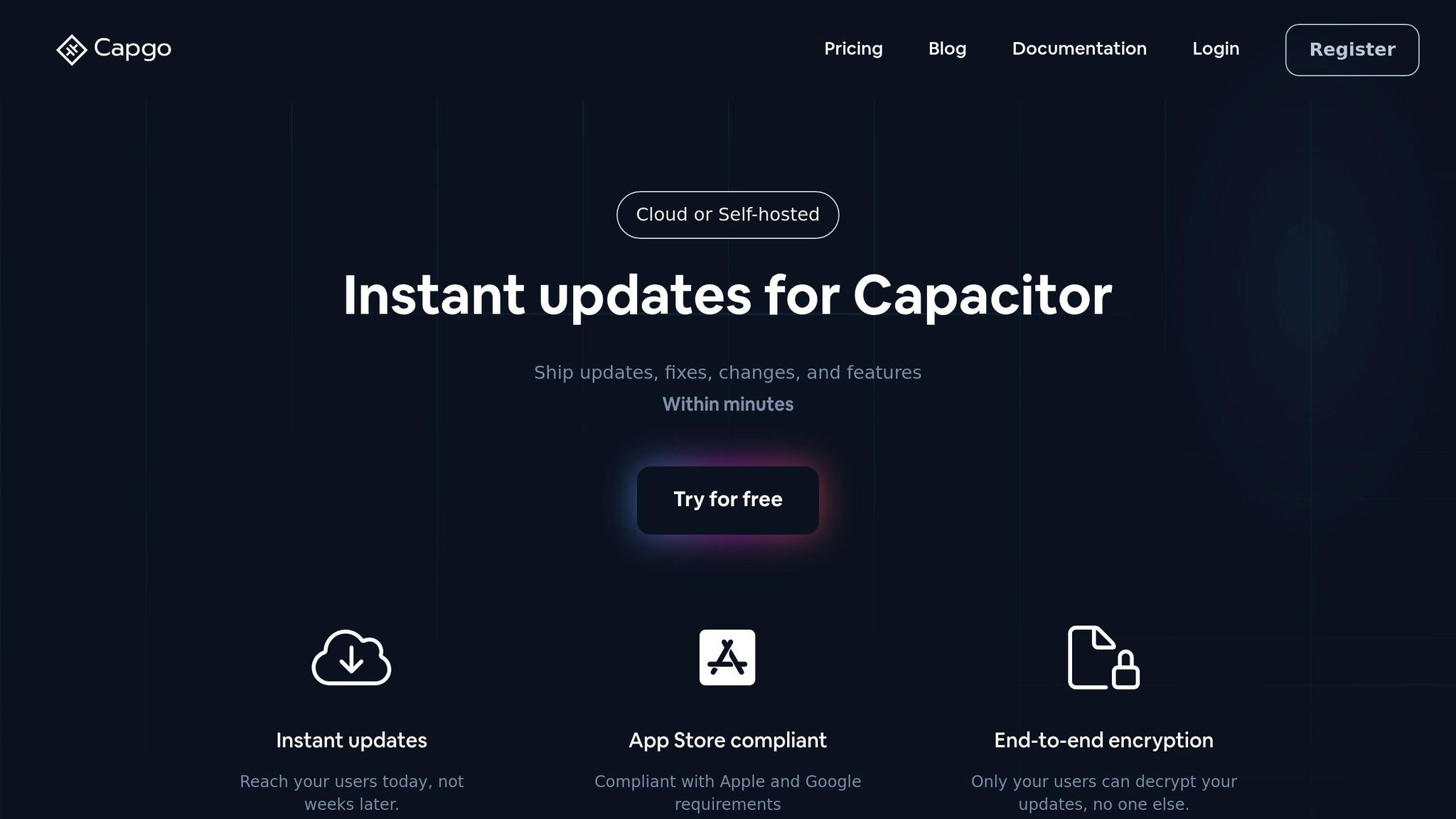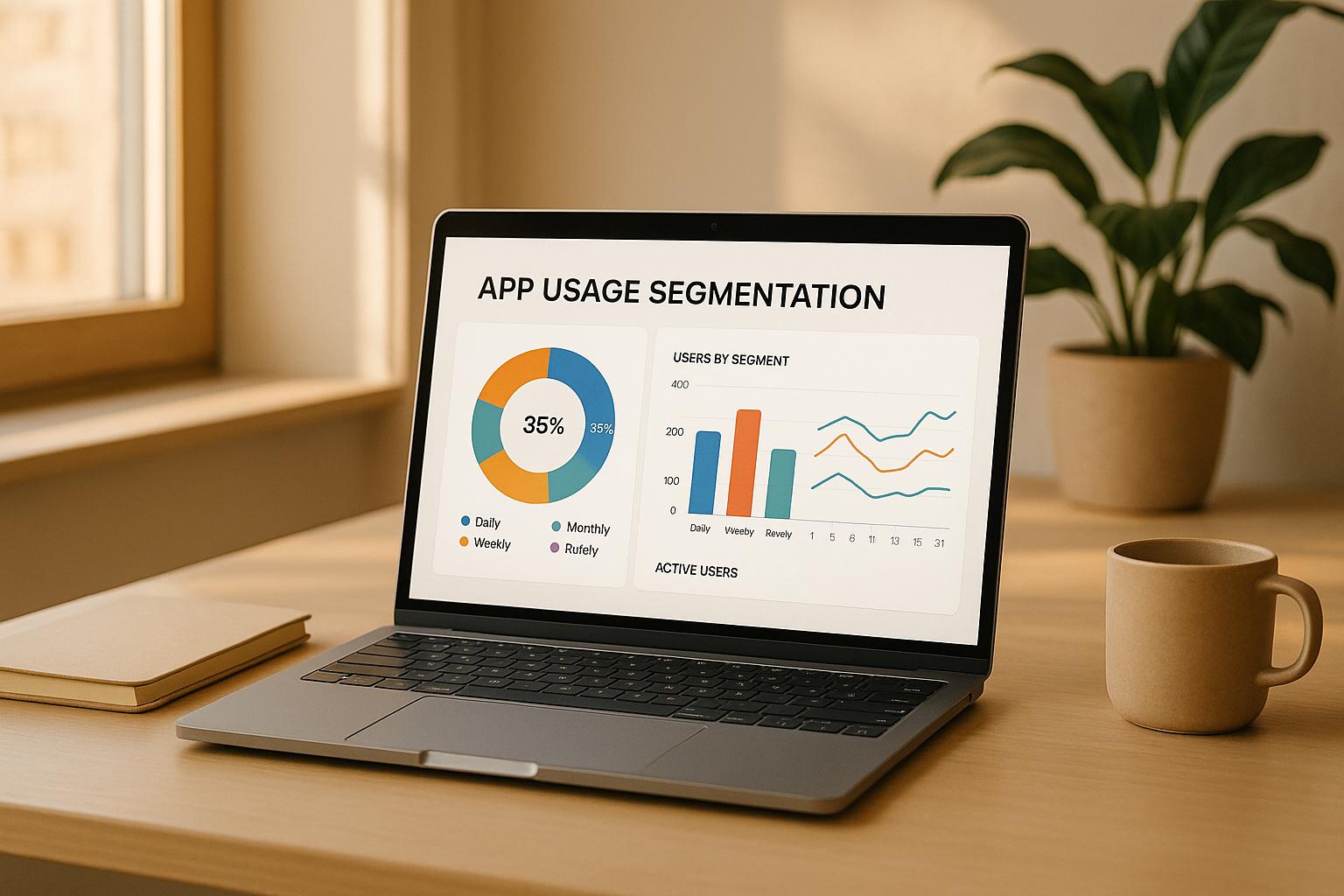Want better app updates? Start by understanding your users. Usage frequency segmentation categorizes users based on how often they interact with your app, helping you deliver updates that actually matter to them. Here’s the breakdown:
- Power Users (10+ sessions/month): Focus on advanced features and early access updates.
- Casual Users (3–9 sessions/month): Improve core functionality and usability.
- At-Risk Users (inactive for 2+ weeks): Prioritize re-engagement and stability.
Why does this matter? Tailored updates increase retention by up to 26%, boost adoption rates by 25–35%, and even reduce support tickets by 30–45%. Tools like Capgo make it easier by offering precise targeting, secure rollouts, and real-time monitoring.
How to do it:
- Track user behavior (sessions, feature usage, update installs).
- Group users by activity level (power, casual, inactive).
- Customize updates for each group (beta testing, staged rollouts, re-engagement).
This approach not only improves user satisfaction but also strengthens your app’s performance.
The Segmentation Blueprint: Identifying What Drives User Retention for Your App
How to Set Up Usage Frequency Segmentation
To effectively implement usage frequency segmentation, you’ll need to track user behavior, organize users into groups based on their activity, and customize updates to meet the needs of each group.
Track Key User Behavior Metrics
Start by monitoring essential engagement metrics to understand how users interact with your product. Here’s a breakdown of what to focus on:
| Metric Type | What to Track | Purpose |
|---|---|---|
| Usage Patterns | Daily/weekly sessions, session duration | Distinguish active users from dormant ones |
| Feature Adoption | Frequency of feature usage, navigation paths | Learn how users engage with specific features |
| Update Behavior | Update installation rates, response time | Gauge the success of your updates |
These insights will help you identify trends and group users based on their activity levels.
Group Users by Activity Level
Once you’ve gathered the data, categorize users into distinct groups. For example:
- Beta Testers: Separate them from regular users to test new features in controlled environments.
- Power Users: Identify these highly active users and consider giving them early access to new features.
- Inactive Users: Flag these users for targeted re-engagement efforts.
- Segmented Update Tracking: Monitor how updates perform across these groups to refine your strategy.
This segmentation allows for a more tailored approach to improving user experience.
Plan Updates for Each User Group
With your users grouped, you can design update strategies that cater to their specific needs. Here’s how to approach each segment:
- Power Users: Create a beta channel where they can test new features and provide feedback before a full release.
- Regular Users: Use staged rollouts to ensure stability. Partial updates can reduce bandwidth demands and speed up downloads.
- Inactive Users: Focus on improving core features and stability. Offering one-click rollback options can encourage these users to re-engage.
Using Capgo for User Targeting

Capgo offers tools that make targeting updates to specific user groups more precise, thanks to its user frequency segmentation features. These capabilities refine the targeted update strategies discussed earlier.
Capgo’s User Assignment Tools
Capgo takes user segmentation a step further by assigning users to specific channels for tailored update rollouts. This channel system ensures updates are delivered with precision:
| User Segment | Channel Type | Update Strategy |
|---|---|---|
| Power Users | Beta Channel | Early access to new features |
| Regular Users | Production Channel | Staged rollouts focused on stability |
| Low Activity Users | Stable Channel | Updates centered on core functionality |
Integrating Segmentation with CI/CD
Capgo integrates smoothly with tools like GitHub Actions, GitLab CI, and Jenkins, making deployments as simple as a single command. Additionally, its public API allows developers to create custom integrations within their existing workflows. This process is designed to work alongside established security protocols.
“End-to-end encryption. Only your users can decrypt your updates, no one else.” - Capgo [2]
Security and Compliance with App Store Rules
Capgo adheres to Apple and Google guidelines by incorporating features like end-to-end encryption, version control, and rollback options. This ensures updates are delivered efficiently and securely, supporting rapid adoption by users across the globe.
Tips for Better User Segmentation
Set the Right Update Frequency
Choosing the right update frequency depends heavily on how users interact with your product. For instance, daily active users thrive on frequent updates that keep them engaged and offer early access to new features. On the other hand, regular users might appreciate updates on a bi-weekly or monthly basis, while low-activity users should only receive critical updates to avoid overwhelming them.
To determine the best schedule, consider factors like usage patterns, the complexity of new features, user feedback, and any technical limitations. Once you’ve established a plan, validate it through beta testing targeted at specific user groups.
Test Your Segmentation Strategy
After setting up your update plan, it’s essential to test your segmentation strategy to ensure it works as intended. Beta testing is a great way to validate your approach before rolling it out to everyone.
| Testing Phase | Duration | Key Metrics |
|---|---|---|
| Initial Beta | 1–2 weeks | Update success rate, crash reports |
| Limited Release | 2–4 weeks | User engagement, feature adoption |
| Full Rollout | 1–2 months | Long-term retention, overall satisfaction |
This phased approach allows you to identify and address potential issues early on. Once testing confirms the strategy’s effectiveness, continue refining it based on results.
Track and Improve Results
Even after testing, the work doesn’t stop. Regularly tracking performance is key to keeping your segmentation strategy sharp. Real-time monitoring can help you spot trends and make adjustments as needed. Tools like Capgo offer analytics to evaluate update performance and a one-click rollback feature to handle any unexpected hiccups.
To get the most out of your segmentation efforts:
- Monitor update adoption rates across different user groups.
- Track error rates to catch and resolve issues quickly.
- Analyze user feedback to understand the specific needs of each segment.
- Leverage Capgo’s rollback feature to minimize disruption when problems arise.
“We rolled out Capgo OTA updates in production for our user base of +5000. We’re seeing very smooth operation almost all our users are up to date within minutes of the OTA being deployed to @Capgo.” - colenso, @colenso [2]
Summary
Results of Good Segmentation
When segmentation is done right, the results speak for themselves. Update adoption rates can climb by 25–35% when updates are delivered based on user activity. At the same time, technical support tickets see a significant drop - around 30–45% - thanks to early detection of potential issues. Even user retention gets a solid boost, improving by 15–25% due to fewer disruptions and more relevant feature rollouts.
Tailored updates also have a direct impact on user engagement. Session lengths increase by 10–20%, and app ratings can jump by as much as a full star. For monetized apps, the effects are even more compelling, with in-app purchases rising by 15–30% when updates are focused on high-value users [1].
These results highlight just how impactful targeted segmentation can be, laying the groundwork for a more customized update strategy powered by Capgo.
Capgo’s Role in Update Targeting
Capgo makes it easy to harness the benefits of segmentation with its live update solution. Using Capgo’s user assignment tools, you can roll out updates to specific user segments with precision. The platform prioritizes secure, compliant updates while offering end-to-end encryption.
| Key Capgo Benefits | Implementation |
|---|---|
| Precision | Deliver updates tailored to specific segments |
| Safety | Rollback updates instantly if needed |
| Monitoring | Track performance in real time |
| Security | Ensure updates are encrypted and meet compliance standards |
“We rolled out Capgo OTA updates in production for our user base of +5000. We’re seeing very smooth operation almost all our users are up to date within minutes of the OTA being deployed to @Capgo.” - colenso, @colenso [2]
FAQs
::: faq
How can usage frequency segmentation improve app update strategies?
Usage frequency segmentation helps developers fine-tune app updates based on how often users interact with the app. By dividing users into categories like frequent, occasional, or rare users, developers can focus on delivering updates that resonate with each group’s specific needs, ultimately boosting satisfaction and retention.
Take frequent users, for instance - they might appreciate updates that enhance performance or introduce advanced features. On the other hand, occasional users may benefit more from updates that simplify navigation or resolve common frustrations. Tools such as Capgo streamline this process by enabling real-time updates for Capacitor apps, ensuring that users receive the right updates instantly, without the hassle of app store approvals. :::
::: faq
What are the key tools and metrics for tracking user behavior to create effective usage segmentation?
To make usage segmentation work effectively, you need to keep a close eye on user behavior through tools and metrics that offer actionable insights. Platforms like Google Analytics or Mixpanel are great for tracking user interactions, session lengths, and how features are being used. On top of that, in-app event tracking can show you exactly how users interact with specific features, while cohort analysis helps uncover trends in user behavior over time.
Key metrics to focus on include retention rates, how often users engage with the app, and overall activity levels. If you’re working with Capacitor apps, tools like Capgo can make this process smoother by delivering updates and features directly to targeted user groups. This allows for a more tailored experience and quicker iteration cycles, keeping your app aligned with user needs. :::
::: faq
How does Capgo help developers streamline app updates and improve the user experience?
Capgo gives developers the ability to push updates, fixes, and new features to their apps instantly - no app store approval delays required. This means you can address user feedback and fix issues as they arise, creating a seamless experience for your users.
Key features like end-to-end encryption, CI/CD integration, and the option to target updates to specific user groups make Capgo both secure and adaptable. Plus, its organization management tools simplify coordination across teams, all while ensuring compliance with Apple and Android guidelines. :::




